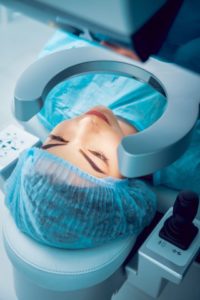Posted by: Georgia Eye Physicians and Surgeons in Latest News
At Georgia Eye Physicians and Surgeons, our board-certified ophthalmologists and optometrists help patients suffering from a wide array of vision problems, ranging from routine inconveniences to diseases that could potentially result in permanent vision loss. Interestingly, there is one treatment method that can be used for conditions in both categories: laser vision technology. The speed and precision of a laser make it ideal for making the extremely minute adjustments necessary in both LASIK vision correction and cataract removal surgery.

LASIK Vision Correction
Simple refractive errors, like nearsightedness, farsightedness, and astigmatism, occur when the shape of the eye is imperfect and the image that is focused by the lens becomes distorted, much like what would happen if the screen in a movie theater was not perfectly flat. During LASIK surgery, Dr. William Segal uses a femtosecond laser, which emits pulses of laser light that last only a few quadrillionths of a second, to make very subtle alterations to the shape of the eye, correcting the refractive errors and making vision clear and sharp.
Cataract Removal Surgery
As the eye gets older, the complex proteins that make up the lens of the eye can start to clump together, forming cataracts that cloud small areas the lens and reduce the sharpness of the image reaching the retina. Once it has begun, this process cannot be reversed and, over time, the cataracts can slowly grow to the point that they significantly obscure vision and may eventually even cause blindness. At this point, the damaged lens must be replaced with an artificial intraocular lens. To accomplish this, Dr. Segal uses the LenSx® laser (the newest and most advanced technology available) to create a small incision in the side of the cornea through which a tiny probe can be inserted. Once the damaged lens is removed, an artificial intraocular lens, or IOL, can then be inserted into the lens capsule, where it becomes a permanent part of the eye.
Even though LASIK vision correction and cataract surgery are intricate procedures requiring a great deal of skill and experience to perform, both can actually be completed relatively quickly and painlessly. Once the eye has been mapped with the Verion™ image guided system, an advanced computer-assisted system that provides the surgeon with a detailed display of the eye in real time, the laser itself is only active for microseconds. Either procedure can usually be completed in as little as fifteen to thirty minutes, with virtually no discomfort and extremely minimal recovery time. If you have questions about the health of your eyes, or would like to schedule a comprehensive eye exam to determine if you are a potential candidate for LASIK vision correction or cataract surgery, please contact Georgia Eye Physicians and Surgeons to make an appointment. Be sure to follow us on Facebook, Twitter, and Google+ for more information on how to keep your vision clear.

